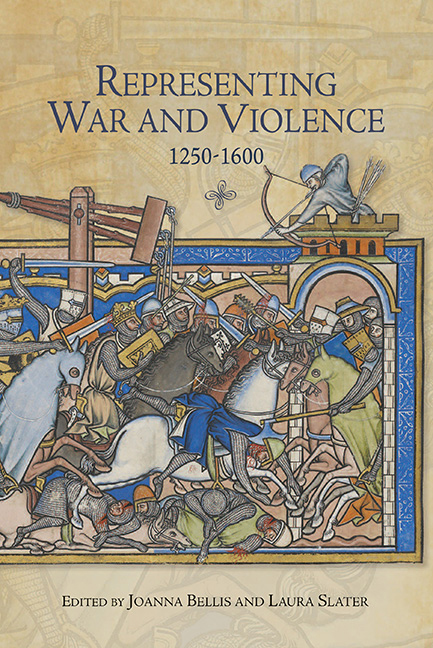Book contents
- Frontmatter
- Contents
- List of Illustrations
- Acknowledgements
- List of Contributors
- Introduction: ‘Representation’ and Medieval Mediations of Violence
- Part I The Ethics and Aesthetics of Depicting War and Violence
- 1 Medieval Warfare – Representation Then and Now
- 2 Depicting Defeat in the Grandes Chroniques de France
- 3 Visualising War: the Aesthetics of Violence in the Alliterative Morte Arthure
- Part II Debating and Narrating Violence
- Part III Experiencing, Representing and Remembering Violence
- Bibliography
- Index
1 - Medieval Warfare – Representation Then and Now
from Part I - The Ethics and Aesthetics of Depicting War and Violence
Published online by Cambridge University Press: 05 September 2016
- Frontmatter
- Contents
- List of Illustrations
- Acknowledgements
- List of Contributors
- Introduction: ‘Representation’ and Medieval Mediations of Violence
- Part I The Ethics and Aesthetics of Depicting War and Violence
- 1 Medieval Warfare – Representation Then and Now
- 2 Depicting Defeat in the Grandes Chroniques de France
- 3 Visualising War: the Aesthetics of Violence in the Alliterative Morte Arthure
- Part II Debating and Narrating Violence
- Part III Experiencing, Representing and Remembering Violence
- Bibliography
- Index
Summary
Late in the summer of 1340 the army of Edward III was besieging the town of Tournai, loyal to the French crown. A French army under Philip VI had manoeuvred nearby with the ambition of relieving the siege. The river Marque, seemingly impassable, separated the two forces. Yet as the chronicler Jean le Bel records, one evening:
Aucuns Brebanchons, Hebignons, Haynuiers parlerrent ensemble, le vespre, quant ilz sceurent que l'ost du roy de France estoit logié si prez d'eulx, et s'acorderrent qu'ilz yroient l'endemain veoir leurs convenances, et s'ilz veoyent leur cop d'aventure, ilz s'aventureroient. Ainsy que acordé fut, ainsy fut fait, et chevaucherrent l'endemain assez prez de l'ost, mais ilz ne passerent pas laditte riviere, et si ne virent nul des Françoys par deça laditte riviere à cui ilz se peussent adventurer. Quant ilz veirent, ilz ne voulurent pas retourner qu'on ne veist de leurs ensaignes, si bouterrent le feu en deux povres maisons qui estoient demourées à ardoir, et puis s'en retournerrent à leurs loges.
Some Hainaulters and men of Brabant and Hesbaye, realizing that the King of France's army was so near, conferred and agreed to go next day and reconnoitre their position, and if they saw an opportunity they'd venture an attack. They did as planned: next morning they rode up close to the enemy; but they didn't cross the river and couldn't see any French troops they could engage. Not wanting to return without leaving their mark, they set fire to two poor dwellings that remained unburnt and then rode back to their quarters.
This fleck of an incident floating on grand currents of political and military history raises some of the most basic issues we can discuss as we seek to understand and represent medieval warfare. This simple scene, more stark than standard accounts of triumph and glory, draws us toward fundamental conceptions about licit violence and those who justly perpetrated it; we step just behind the rich screen of the usual medieval representation in manuscript pages or many painted or carved works. The chroniclers, artists and craftsmen who penned, painted or sculpted reveal the mindsets of their patrons within the ruling elite. Upon these medieval works much modern analysis and scholarly representation depends.
- Type
- Chapter
- Information
- Representing War and Violence, 1250-1600 , pp. 23 - 38Publisher: Boydell & BrewerPrint publication year: 2016



